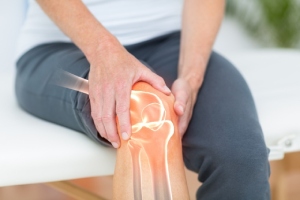What Causes Arthritis and How You Can Ease Joint Pain
|
Reading time: 9 minutes
|

Key Takeaways
- Arthritis can affect people of all ages and comes in many forms. It causes joint pain, stiffness, or swelling. It may be linked to aging, past injuries, infections, or how the immune system works.
- Daily habits like movement, healthy eating, and joint care can help manage arthritis. Walking, stretching, and eating foods that lower swelling can support joint health. Some people also feel better with arthritis medications or relief products.
- There is no cure for arthritis, but many people find relief with the right care. Gentle exercise, smart food choices, and support from doctors can improve comfort and help with daily activities.
Arthritis is a health condition that causes pain, swelling, or stiffness in the joints. A joint is the place where two bones meet, like your knee, hip, or elbow. When a person has arthritis, it can hurt to move or bend those joints.
There are over 100 different types of arthritis. Some people may feel light pain, while others may have trouble walking, holding things, or doing daily tasks.
Arthritis is very common. In the United States, more than 50 million people live with it. It can affect anyone, but it happens more often as people get older.
Learning about arthritis helps people make smart choices for their health. Understanding what causes the pain can lead to better ways to feel more comfortable. This may include small changes, like staying active, eating well, or using pain relief medications and other arthritis treatments that help with swelling and discomfort.
What Makes Arthritis So Painful?
Arthritis pain starts in the joints—the places where bones meet and move. When the inside of a joint gets swollen or damaged, movement can feel sore or stiff.
Different types of arthritis cause pain in different ways. The most common type is osteoarthritis. This happens when the smooth layer of cartilage between bones wears down. Cartilage helps bones move without rubbing. Some common symptoms of osteoarthritis include joint pain, stiffness, and a limited range of motion. When it’s gone, bones can grind against each other, which causes pain and makes the joint harder to move.
Another type is called rheumatoid arthritis. This kind of arthritis is linked to the immune system. Instead of protecting the body, the immune system attacks healthy joints. This leads to swelling and may damage bones, muscles, or even organs.
A third kind is called infectious arthritis. In this case, germs like bacteria or viruses get into a joint. The body reacts by making the joint painful and swollen. Doctors often treat this type of arthritis with antibiotics to help remove the infection. It can come on quickly and should be treated right away.
Arthritis pain can make everyday life harder. Some people may struggle to walk, hold objects, or sleep well. Relief may come from gentle movement, healthy habits, or using arthritis medications that help with swelling and pain.
Arthritis Comes in Many Forms
Arthritis is not just one illness. It is a word used for over 100 different conditions that cause pain, swelling, or stiffness in the joints. These conditions can affect people in different ways.
Some types of arthritis happen from wear and tear over time. Other types are caused by problems with the immune system, infections, or even skin diseases. In some cases, doctors do not know the exact cause.
Symptoms are not the same for everyone. One person may feel stiff in the morning. Others might feel pain when walking, bending, or using their hands. Some people may notice swelling, warmth, or redness around their joints.
Since there are many forms of arthritis, treatment depends on the type. Doctors often look at the symptoms and causes before choosing a plan. Care might include exercise, joint support, or arthritis medications that help manage pain and swelling.
Talking to a doctor can help you find out what type of arthritis you have. This makes it easier to choose the right steps to feel better—whether that means staying active, using support tools, or finding the best medicine for your needs.
Why Osteoarthritis Often Leads to Joint Replacements
Osteoarthritis is the most common form of arthritis. It happens when the smooth layer of cartilage in the joints wears down over time. Cartilage helps bones move without rubbing together.
As people age, cartilage can slowly break down. This can also happen faster if someone has joint injuries, puts stress on their joints, or carries extra body weight.
When cartilage is mostly gone, the bones in the joint may grind against each other. This can lead to pain, swelling, and a loss of movement. The joint may feel stiff or become weak.
Osteoarthritis often affects the knees and hips. These joints carry much of the body’s weight, so they tend to wear out faster than others.
Sometimes, the damage becomes too great to fix with regular treatment. In those cases, a doctor may recommend surgery to replace the joint. A knee or hip replacement removes the damaged joint and replaces it with a new one made from metal or plastic.
After surgery, people often use movement therapy and medications to heal and manage pain. Some also use arthritis relief products like joint supports or cushions to stay comfortable during recovery.
Movement Helps with Arthritis
People with arthritis may feel pain when they move. Because of this, some people stop being active or rest more than usual. But staying still for too long can make joints feel worse.
When a joint is not used, it can become stiff and weak. The muscles around it may also lose strength. This makes it harder to move the joint without pain.
Gentle movement can help keep joints working better. Walking, swimming, and biking are good choices. These activities are soft on the joints and help improve blood flow and flexibility.
Yoga and stretching can also be useful. They support balance, strength, and range of motion. Even a few minutes each day can make a difference over time.
Some people use both movement and arthritis medications to manage their symptoms. This mix may reduce pain and make it easier to do daily activities. Others also use pain relief products to stay more comfortable while moving.
Can You Lower Your Risk of Arthritis?
Some habits may help reduce your chance of getting arthritis or delay when it starts. These habits often include how you move, what you eat, and how much you weigh.
Keeping a healthy weight can protect your joints. When someone carries extra weight, their joints—especially the knees, hips, and feet—feel more pressure. Over time, this can wear down the cartilage that cushions the bones.
What you eat also matters. Foods like fruits, vegetables, whole grains, and healthy fats may help lower swelling in the body. These choices can support long-term joint health.
Research studies reveal that eating too much sugar may raise inflammation in the body. Over time, this can increase the chance of joint pain and damage. Foods like candy, soda, and fried snacks may worsen arthritis symptoms.
Gentle, regular exercise keeps joints strong and flexible. It also helps control weight and improves balance. Walking, stretching, and swimming are all good options and can be done at any age.
Some people may also use joint-friendly treatments or supplements to support their joints early. These may help with comfort and movement before symptoms appear. A doctor can help find the best option based on your health and family history.
Who Gets Arthritis and Why?
Some people have a higher chance of getting arthritis than others. This can be linked to age, gender, past injuries, or changes in the body over time.
Getting older is one of the most common risk factors. As people age, their joints go through more wear and tear. The cartilage that protects the bones can wear down, which may lead to pain and stiffness.
Gender also plays a part. Women are more likely than men to get certain kinds of arthritis, especially after menopause. Older women have one of the highest risks because hormone changes and aging can both affect the joints. These changes may lead to more swelling and joint pain over time.
Injuries can raise the risk of arthritis later in life. Sports accidents, falls, or doing the same joint movements over and over can cause damage. Even small injuries from the past can affect how a joint works today.
Some people notice joint changes when they start or stop taking certain medications. Hormone changes, like those after pregnancy or menopause, can also lead to more inflammation.
Knowing your risk can help you make choices that protect your joints. This might include low-impact movement, using joint supports, or asking a doctor about arthritis relief or treatment options.
Kids Can Have Arthritis Too
Arthritis can affect children, not just adults. When a child has joint pain or swelling that doesn’t go away, it might be a sign of juvenile arthritis.
Juvenile arthritis is the name for arthritis that starts before age 16. It can cause swelling, stiffness, and pain in the joints, just like in adults. Some kids may have trouble getting out of bed or doing normal activities like playing or running.
There are different types of juvenile arthritis. Some types affect just a few joints, like the knees, ankles, or wrists. Other types affect many joints at once. Some children may also get rashes, fevers, or eye problems along with joint pain.
One type, called oligoarticular arthritis, affects four or fewer joints. Another type, polyarticular arthritis, affects five or more joints. Systemic arthritis is more rare and can affect the whole body, not just the joints.
Juvenile arthritis can show up in different ways. Some kids may feel tired or want to rest more. Others may feel fine one day and sore the next.
Like adults, kids may feel better with early care, gentle movement, and safe arthritis medications. These steps may help lower pain, protect growing joints, and support a more active and healthy life.
Final Thoughts
Arthritis can cause joint pain, swelling, and make it harder to move. But many people feel better by taking small steps to care for their joints every day.
Moving your body can help joints stay flexible and strong. Gentle activities like walking, swimming, and stretching are easy on the joints and help with comfort over time.
Eating healthy foods can also support joint health. Fruits, vegetables, and whole grains may help reduce swelling. Avoiding sugary or processed foods can also make a difference.
Arthritis looks different for each person. That’s why some people use a mix of movement, good food choices, and arthritis medications to feel better and stay active.
There is no cure for arthritis, but there are many ways to manage the pain. Treatments, support tools, and healthy habits can help improve daily life.
If you want to feel more comfortable, talk to your doctor or explore arthritis relief options that match your needs.
Click here for more information about finding a trusted online pharmacy or pain relief products.
Information provided on this website is for general purposes only. It is not intended to take the place of advice from your practitioner







